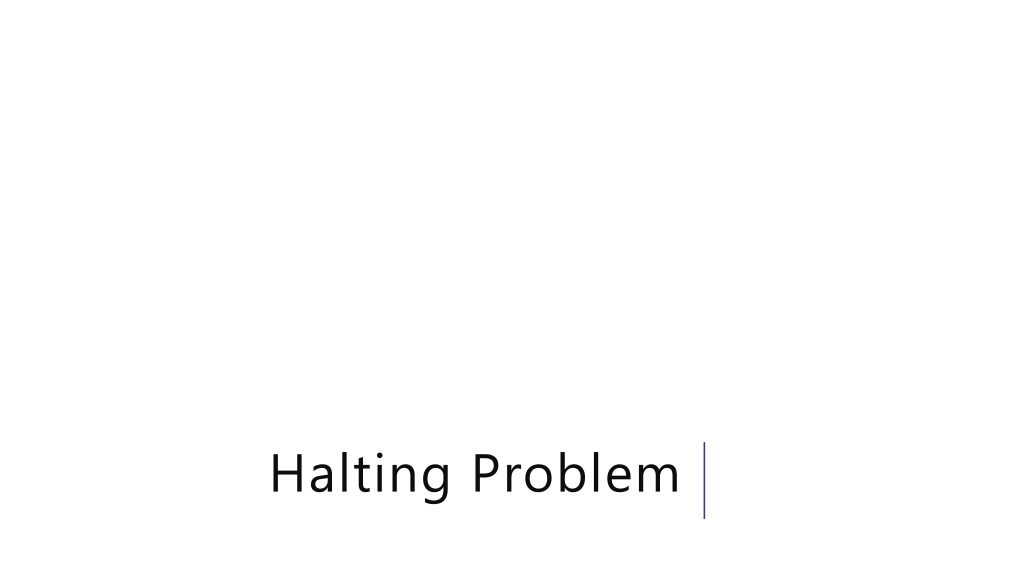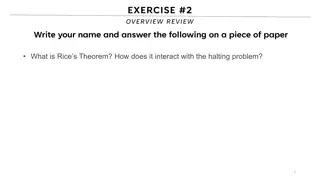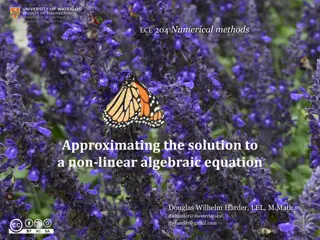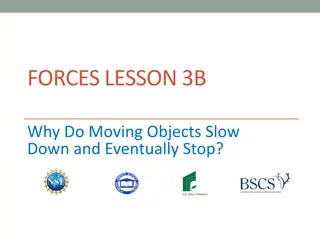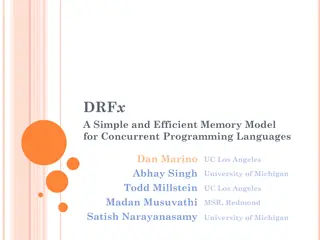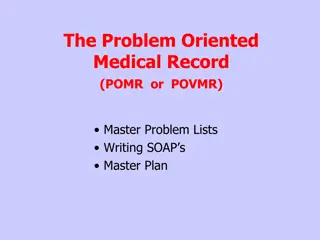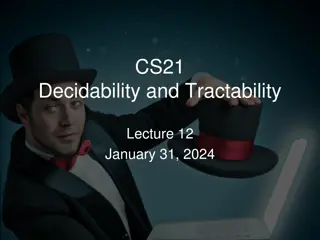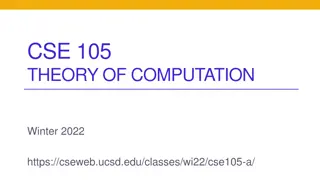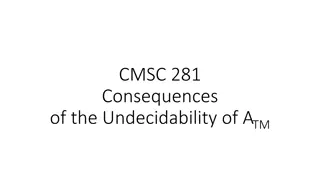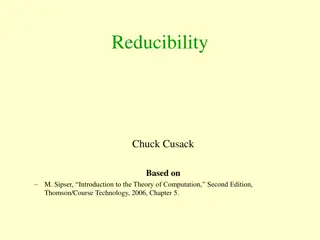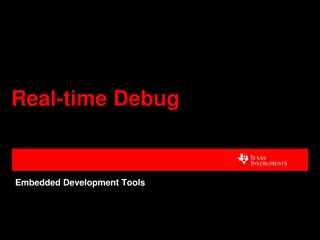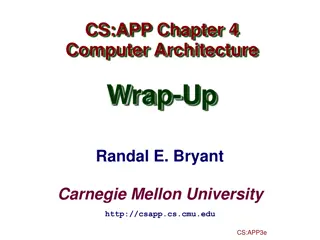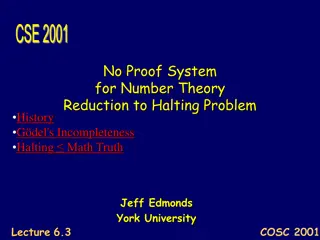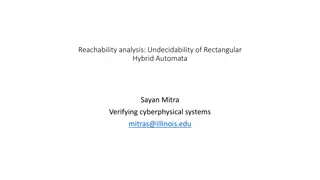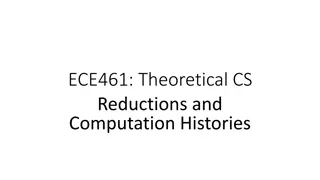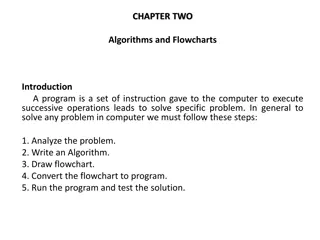Understanding the Halting Problem and Uncomputable Programs
The Halting Problem in computer science presents a practical uncomputable problem where determining whether a program will halt or run forever is impossible. This concept is explored through a proof by contradiction and a tricky program called Diagonal.java. The program showcases the challenges of predicting program behavior in the presence of infinite loops, leading to a deeper understanding of computability limitations.
Download Presentation

Please find below an Image/Link to download the presentation.
The content on the website is provided AS IS for your information and personal use only. It may not be sold, licensed, or shared on other websites without obtaining consent from the author. Download presentation by click this link. If you encounter any issues during the download, it is possible that the publisher has removed the file from their server.
E N D
Presentation Transcript
A Practical Uncomputable Problem Every pressed the run button on your code and have it take a long time? Like an infinitely long time? What didn t your compiler like, tell you not It tells you when your code doesn t compile before it runs it why doesn t it check for infinite loops? not to push the button yet.
The Halting Problem The Halting Problem Given: source code for a program ? and ? an input we could give to ? Return: True if ? will halt on ?, False if it runs forever (e.g. goes in an infinite loop or infinitely recurses) This would be super useful to solve! We can t solve it let s find out why.
A Proof By Contradiction Suppose, for the sake of contradiction, there is a program ?, which given input P.java,? will accurately report ? would halt when run with input ? or ? will run forever on input ?. Important: Important: ? does not just compile P.java and run it. To count, ? needs to return halt or doesn t in a finite amount of time. And remember, it s not a good idea to say but ? has to run P.java to tell if it ll go into an infinite loop that s what we re trying to prove!!
A Very Tricky Program. Diagonal.java(String x){ Run H.exe on input <x, x> if(H.exe says x halts on x ) while(true){//Go into an infinite loop int x=2+2; } else //H.exe says x doesn t halt on x return; //halt. }
So, uhh thats a weird program. What do we do with it? USE IT TO BREAK STUFF Does Diagonal.java halt when its input is Diagonal.java? Let s assume it does and see what happens
A Very Tricky Program. Imagine Diagonal.java halts on Diagonal.java. Then H better say it halts. So it goes into an infinite loop. Diagonal.java(String x){ Run H.exe on input <x, x> if(H.exe says x halts on x ) while(true){//Go into an infinite loop int x=2+2; } else //H.exe says x doesn t halt on x return; //halt. } Wait shoot.
So, uhh thats a weird program. What do we do with it? USE IT TO BREAK STUFF Does Diagonal.java halt when its input is Diagonal.java? Let s assume it does and see what happens That didn t work. Let s assume it doesn t and see what happens
A Very Tricky Program. Imagine Diagonal.java doesn t halt on Diagonal.java. Then H better say it doesn t halt. So we go into the else branch. And it halts Diagonal.java(String x){ Run H.exe on input <x, x> if(H.exe says x halts on x ) while(true){//Go into an infinite loop int x=2+2; } else //H.exe says x doesn t halt on x return; //halt. } Wait shoot.
So, uhh thats a weird program. What do we do with it? USE IT TO BREAK STUFF Does Diagonal.java halt when its input is Diagonal.java? Let s assume it does and see what happens That didn t work. Let s assume it doesn t and see what happens That didn t work either. There s no third option. It either halts or it doesn t. And it doesn t do either. That s a contradiction! H.exe can t exist.
So So there is no general-purpose algorithm that decides whether any input program (on any input string). The Halting Problem is undecidable (i.e. uncomputable) there is no algorithm that solves every instance of the problem correctly.
What that does and doesnt mean That doesn t mean that there aren t algorithms that often get the answer right For example, if there s no loops, no recursion, and no method calls, it definitely halts. No problem with that kind of program existing. This isn t just a failure of computers if you think you hand, well you cant either. you can do this by
Takeaways Don t expect that there s a better IDE/better compiler/better programming language coming that will make it possible to tell if your code is going to hit an infinite loop. It s not coming.
More Uncomputable problems Imagine we gave the following task to 142 students: Write a program that prints Hello World Can you make an autograder? Technically NO!
More Uncomputable problems Imagine we gave the following task to 142 students: Write a program that prints Hello World Can you make an autograder? Technically NO! In practice, we declare the program wrong if it runs for 1 minute or so. That s not right 100% of the time, but it s good enough for your programming classes.
How Would we prove that? With a reduction reduction Suppose, for the sake of contradiction, I can solve the HelloWorld problem. (i.e. on input P.java I can tell whether it eventually prints HelloWorld) Let W.exe solve that problem. Consider this program
A Reduction Trick(P,x){ Run P on x, //(but only simulate printing if P prints things) Print Hello World } This actually prints hello world iff P halts on x. Plug Trick into W and .we solved the Halting Problem!
Reductions in General The big idea for reductions is reusing code Just like calling a library But doing it in contrapositive form. Instead of If I have a library, then I can solve a new problem reductions do the contrapositive: If I can solve a problem I know I shouldn t be able to, then that library function can t exist
Fun (Scary?) Fact Rice s Theorem Says any non-trivial behavior of programs cannot be computed (in finite time).
What Comes next? CSE 312 (foundations II) Fewer proofs Basics of probability theory (super useful in algorithms, ML, and just everyday life). Fundamental statistics. CSE 332 (data structures and parallelism) Data structures, a few fundamental algorithms, parallelism. Graphs. Graphs everywhere. Also, induction. [same for 421, 422 the algorithms courses] CSE 431 (complexity theory) What can t you do with computers in a reasonable amount of time. in a reasonable amount of time. Beautiful theorems more on CFGs, DFAs/NFAs as well.
Weve Covered A LOT Propositional Logic. Boolean logic and circuits. Boolean algebra. Predicates, quantifiers and predicate logic. Inference rules and formal proofs for propositional and predicate logic. English proofs. Set theory. Modular arithmetic. Prime numbers. GCD, Euclid's algorithm and modular inverse You ll use quantifiers in 332 to define big-O 431 is basically 10 weeks of fun set proofs. Interested in crypto? They ll come back.
No really. A lot Induction and Strong Induction. Recursively defined functions and sets. Structural induction. Regular expressions. Context-free grammars and languages. Relations and composition. Transitive-reflexive closure. Graph representation of relations and their closures. You ll use graphs at least once a week for the rest of your CS career. Lots of induction proof [sketches] in 332 You ll see these in compilers
Like A lot a lot. DFAs, NFAs and language recognition. Cross Product construction for DFAs. Finite state machines with outputs at states. Conversion of regular expressions to NFAs. Powerset construction to convert NFAs to DFAs. Equivalence of DFAs, NFAs, Regular Expressions Method to prove languages not accepted by DFAs. Cardinality, countability and diagonalization Undecidability: Halting problem and evaluating properties of programs. Promise you won t ever try to solve the Halting Problem? It s tempting to try to sometimes if you don t remember it s undecidable
